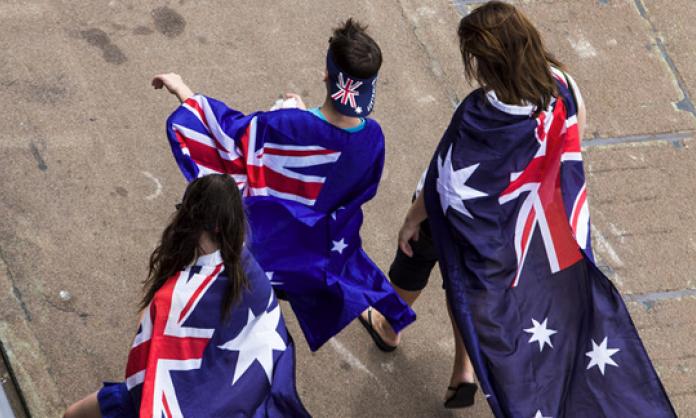When I was growing up, flying the Australian flag was a weird thing to do.
There was one house in my 1980s neighbourhood that had one out the front, but everyone regarded its occupants as freaks. It seemed like the sort of insane teary-eyed British patriotism that we’d seen satirised on The Goodies, and we half suspected they would be wearing Tim Brooke-Taylor-style Union Jack belly button protectors. Weird.
Jump forward 30 years and the picture is very different. Increasingly, the thing seems to be hoisted over, pasted upon, sewn into or painted on any surface you could imagine – from processed snack foods to garbage bags, and from toilet brushes to F-35 fighter planes.
Ever since Pauline Hanson first appeared in photos with the rotten thing draped around her (the first time in my life I’d ever seen a person behave in such a way), we’ve seen an explosion in the numbers of racist thugs in Australian flag capes.
From the Cronulla anti-Lebanese riot to the rise of today’s fascist United Patriots Front, the sight of a young white male wearing a flag now carries the threat of impending racist violence.
The Labor Party too is caught up in the flag frenzy. They might not wrap themselves in it, but they certainly like to fly it. What a difference from the situation when Paul Keating was prime minister and refused to fly those ridiculous little flags on the bonnet of the prime ministerial car. When journalists asked him to explain, he brushed it aside as “no big deal”. And it wasn’t.
What has changed in Australian capitalism to make the flag so important? It’s partly rooted in the continuing neoliberal push, with its attacks on the old traditions of social welfare and the ongoing erosion of the welfare state. In that context, a resurgent nationalism is central in forging a fake sense of community and papering over the real divides in society.
But it’s also bound up with the renaissance of Australian imperialism from the 1990s, when the Australian state sought to rehabilitate the image of its armed forces. This has involved a torrent of propaganda linking the flag with the glorified and fictionalised war heroes of old.
Right wingers proclaim the sanctity of the flag with the cry “our diggers fought under it”. It’s the worst type of noxious nationalism. It’s also untrue. There was a time, in the late 1980s and early 1990s, when even the ruling Labor Party could dismiss such claims. At one point it wheeled out former PM Gough Whitlam, who had been an RAAF pilot in WWII, to declare this was certainly not the flag that he remembered serving under. There were red flags, white flags and an assortment of Union Jacks, but not the Australian flag.
Even if Australian troops had served under the current flag, what would be the implication? That this is the flag that fluttered atop the destroyed villages, the broken and raped bodies and the bombed-out civilian infrastructure that were the immediate consequences of a string of Australian imperialist wars. Would that be something to be proud of?
In fact, the current Australian flag was made official only in 1953, when the Menzies government passed the Flags Act. Prior to this, Australia had no official national flag. Public buildings often flew the British Union Jack.
The design of the flag dates back to Federation. At that time the largest star featured six points – one for each state. The common assumption, drilled into our heads as schoolkids and validated by the wording of the Flags Act, is that the seven-pointed star replaced the six-pointed star in 1911 when the federal territories of NT and ACT joined the six Australian states.
This is also untrue. The star went from six points to seven in 1908. Why? To mark the Australian state’s imperialist takeover of Papua, which the Queensland government had forcibly annexed in 1883 and which Australia took full control over in 1906.
The flag has always been a symbol of imperialism – not least of all in relation to the invasion and genocide that founded the Australian state itself.





